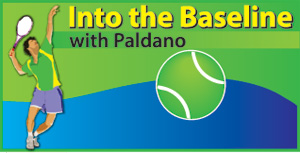Mentalist Paul Annacone saga and Europe’s slow red clay tennis
View(s):The Top 50 of the women’s world ranked players are from 20 countries, it is the same of ATP is from 22 countries. What separates these players from the rest in the ranking is not the large margin in playing ability. The Top 10 often are victims of the 40 below. So are the rest below. Tennis is about skill, tactics, speed, endurance, mental stability, innovation and adaptability. Creating this all-in-one player is demanding for players, parents and coaches.
 For players living in one of the 22 countries, with top end players, there are many advantages. Other nationalities will have to relocate themselves to such countries. The Russian example of last 30 years showed this is possible. Maria Sharapova’s success is one such case.
For players living in one of the 22 countries, with top end players, there are many advantages. Other nationalities will have to relocate themselves to such countries. The Russian example of last 30 years showed this is possible. Maria Sharapova’s success is one such case.
Paris sand title
The WTA/ATP sand court events, which is on now, will culminate in the French Open. Which Rafael Nadal won many times and many big names never. They are slow, so slow Rod Laver, the last Grand Slam winner said can play sipping a cup of tea! [Our courts are raw clay, French Open is burnt clay granulated. There are many types of clay/sand courts]
Playing ability in most players is habitual, change of surface demands changes in every aspect of the game. They are very complicated to alter in the timeframe tennis permits between shots.
Spanish, Italian, Indian, Mexicans and South American are sand court specialists. Our players’ best performances has been on sand courts, even now we play our Davis Cup ties on sand. Often Davis Cup court made afresh to appease ITF. The change baffles local players more.
Run up to French Open
This is where we are at present in professional tennis. In the past decade, ATP’s famous trio Roger Federer, Rafael Nadal and Novak Djokovic, dominated the Paris run up. This year, run up to Paris had multiple winners. Alexander Zverev won Rome, Andrey Rublev took Madrid, Casper Ruud in Barcelona, Lennard Sturff was the surprise of Stuttgart, Matteo Berettini in Morroco, and Herbert Hurcacz won Lisbon while Stefanos Tisitsipas is the Monte Carlo hero.
Strangely, the top three of the ATP ranking, Novak Djokovic, Janik Sinner and Carlos Alcaraz did not win any. After 15 weeks into the professional circuit injuries and exhaustion has taken a toll. Meanwhile South Americans from Chile surfaced and overcame unsettled top end of ATP. Nicholas Jerry, his grand farther Jaime Filloi and granduncle Allapo Filloi were known players and his mother Catalina is the Director of the professional event of Santiago de Chile. The other Chilean was Alejandro Tabilo. He was great in Rome.
WTA run up to Paris
Iga Swiatek of Poland and Aryna Sabalenka of Belarus dominate almost appearing in the final of every event. Others prominent in the WTA ranking are, Coco Gauff and Jessika Pegula of USA, Elena Rybakina of Kazakhstan, surprises from Elina Svitolina of Ukraine, Daria Kasatskina of Russia and Qin Wen Zeng of China. The athletics, tactical play, mental toughness and endurance of Swiatek is commendable. She is the best prospect for the French Open title.
Paul Annacone of USA – the mentalist
Annacone was a player, development coach and mentor. Many, if not all, speak about mental aspect of the game. Annacone devised methodology to use the mental aspect to win and most importantly a design to detect and utilise.
Annacone was a brilliant college level player in USA, where he almost never lost a match. Stepping into the professional circuit, he could not sustain the same success rate. In the Grand Slam events, his best was the second round. His parents were in university level teaching profession. Here is what his mother told him.
Left hand has useless dirt and the right hand all the best skills. At any time in a match, a player is between these two extremes. What she implied was that our thought decides our efficiency and not any external factors. Our opponents cannot control our thoughts. Anncone showed how and why we have to use our mental faculty to win. A player’s comfort zone is in their thought. He admits his transition from player to coach was a difficult one. Very few reach the comfort zone in teaching even after being in a Top 10 player of the world. It is a different road plan to be player and completely different road map to teach competition tennis. Being a good player will certainly help.
Anncone used experiences well. He noticed the inadequacies of drill coaching and same tactic for all players approach. Tennis is individual. Today his name attached to successes of Jimmy Connors, Pete Sampras, Roger Federer, Stan Wawrinka, Tim Henman and Sloane Stephens. Total of 37 professional carrier titles.
–George Paldano, European and Asian competition player; Coach German Tennis Federation; National coach Brunei and Sri Lanka; Davis Cup, Federation Cup coach, coached ATP, WTA and ITF ranked players in Europe and Asia; WhatsApp +94775448880–


